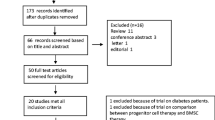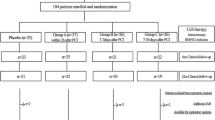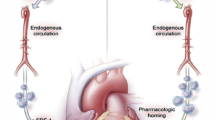Abstract
Background
Intracoronary administration of autologous bone marrow stem cells (BMC) has been shown to result in a subtle improvement of global left ventricular ejection fraction after ST-elevation myocardial infarction (STEMI), but the overall benefits of BMC therapy are still unclear. We studied the influence of intracoronary injections of BMC on levels of natriuretic peptides and inflammatory mediators, which are well established prognostic biomarkers, in patients with STEMI.
Methods
In this randomized, double-blind study, consecutive patients with an acute STEMI treated with thrombolysis followed by PCI 2–6 days after STEMI, were randomly assigned to receive either intracoronary BMC or placebo medium into the infarct-related artery. Blood samples were drawn for biochemical determinations.
Results
From baseline to 6 months, there was a significant decrease in the levels of N-terminal probrain natriuretic peptide (NT-proBNP), interleukin-6 (IL-6) and high-sensitivity C-reactive protein (hsCRP) in the whole patient population (P < 0.001 for all). However, no difference was observed between the BMC group (n = 39) and the placebo group (n = 39) in the change of the levels of NT-proANP (median −54 vs. +112 pmol/L), NT-proBNP (−88 vs. −115 pmol/L) or inflammatory markers IL-6 (−3.86 vs. −5.61 pg/mL), hsCRP (−20.29 vs. −22.36 mg/L) and tumor necrosis factor α (−0.12 vs. −0.80 pg/mL) between baseline and 6 months.
Conclusion
Intracoronary BMC therapy does not appear to exert any significant effects on the secretion of natriuretic peptides or inflammatory biomarkers in STEMI patients.



Similar content being viewed by others
References
Strauer BE, Brehm M, Zeus T, Köstering M, Hernandez A, Sorg RV, Kögler G, Wernet P (2002) Repair of infarcted myocardium by autologous intracoronary mononuclear bone marrow cell transplantation in humans. Circulation 106:1913–1918
Schächinger V, Assmus B, Britten MB, Honold J, Lehmann R, Teupe C, Abolmaali ND, Vogl TJ, Hofmann WK, Martin H, Dimmeler S, Zeiher AM (2004) Transplantation of progenitor cells and regeneration enhancement in acute myocardial infarction: final one-year results of the TOPCARE-AMI trial. J Am Coll Cardiol 44:1690–1699
Wollert KC, Meyer GP, Lotz J, Ringes-Lichtenberg S, Lippolt P, Breidenbach C, Fichtner S, Korte T, Hornig B, Messinger D, Arseniev L, Hertenstein B, Ganser A, Drexler H (2004) Intracoronary autologous bone-marrow cell transfer after myocardial infarction: the BOOST randomised controlled clinical trial. Lancet 364:141–148
Bartunek J, Vanderheyden M, Vandekerckhove B, Mansour S, De Bruyne B, De Bondt P, Van Haute I, Lootens N, Heyndrickx G, Wijns W (2005) Intracoronary injection of CD 133-positive enriched bone marrow progenitor cells promotes cardiac recovery after recent myocardial infarction: feasibility and safety. Circulation 112:1178–1183
Ge J, Li Y, Qian J, Shi J, Wang Q, Niu Y, Fan B, Liu X, Zhang S, Sun A, Zou Y (2006) Efficacy of emergent transcatheter transplantation of stem cells for treatment of acute myocardial infarction (TCT-STAMI). Heart 92:1764–1767
Meluzín J, Mayer J, Groch L, Janousek S, Hornácek I, Hlinomaz O, Kala P, Panovský R, Prásek J, Kamínek M, Stanícek J, Klabusay M, Korístek Z, Navrátil M, Dusek L, Vinklárková J (2006) Autologous transplantation of mononuclear bone marrow cells in patients with acute myocardial infarction: the effect of the dose of transplanted cells on myocardial function. Am Heart J 152:975.e9–975.e15
Schächinger V, Erbs S, Elsässer A, Haberbosch W, Hambrecht R, Hölschermann H, Yu J, Corti R, Mathey DG, Hamm CW, Süselbeck T, Assmus B, Tonn T, Dimmeler S, Zeiher AM, REPAIR-AMI investigators (2006) Intracoronary bone marrow-derived progenitor cells in acute myocardial infarction. N Engl J Med 355:1210–1221
Huikuri HV, Kervinen K, Niemelä M, Ylitalo K, Säily M, Koistinen P, Savolainen ER, Ukkonen H, Pietilä M, Airaksinen JK, Knuuti J, Mäkikallio TH, FINCELL investigators (2008) Effects of intracoronary injection of mononuclear bone marrow cells on left ventricular function, arrhythmia risk profile, and restenosis after thrombolytic therapy of acute myocardial infarction. Eur Heart J 29:2723–2732
Kwon TG, Bae JH, Jeong MH, Kim YJ, Hur SH, Seong IW, Cho MC, Seung KB, Jang YS, Park SJ, Korea Acute Myocardial Infarction Registry Investigators (2009) N-terminal pro-B-type natriuretic peptide is associated with adverse short-term clinical outcomes in patients with acute ST-elevation myocardial infarction underwent primary percutaneous coronary intervention. Int J Cardiol 133:173–178
Valente S, Lazzeri C, Chiostri M, Giglioli C, Sori A, Tigli S, Gensini GF (2009) NT-proBNP on admission for early risk stratification in STEMI patients submitted to PCI. Relation with extension of STEMI and inflammatory markers. Int J Cardiol 132:84–89
Otterstad JE, St John Sutton MG, Froeland GS, Holme I, Skjaerpe T, Hall C (2002) Prognostic value of two-dimensional echocardiography and N-terminal proatrial natriuretic peptide following an acute myocardial infarction. Assessment of baseline values (2–7 days) and changes at 3 months in patients with a preserved systolic function. Eur Heart J 23:1011–1020
Berger R, Huelsman M, Strecker K, Bojic A, Moser P, Stanek B, Pacher R (2002) B-type natriuretic peptide predicts sudden death in patients with chronic heart failure. Circulation 105:2392–2397
Simon T, Becker R, Voss F, Bikou O, Hauck M, Licka M, Katus HA, Bauer A (2008) Elevated B-type natriuretic peptide levels in patients with nonischemic cardiomyopathy predict occurrence of arrhythmic events. Clin Res Cardiol 97:306–309
Hwang HJ, Son JW, Nam BH, Joung B, Lee B, Kim JB, Lee MH, Jang Y, Chung N, Shim WH, Cho SY, Kim SS (2009) Incremental predictive value of pre-procedural N-terminal pro-B-type natriuretic peptide for short-term recurrence in atrial fibrillation ablation. Clin Res Cardiol 98:213–218
Järemo P, Nilsson O (2008) Interleukin-6 and neutrophils are associated with long-term survival after acute myocardial infarction. Eur J Intern Med 19:330–333
Debrunner M, Schuiki E, Minder E, Straumann E, Naegeli B, Mury R, Bertel O, Frielingsdorf J (2008) Proinflammatory cytokines in acute myocardial infarction with and without cardiogenic shock. Clin Res Cardiol 97:298–305
Ma KK, Ogawa T, de Bold AJ (2004) Selective upregulation of cardiac brain natriuretic peptide at the transcriptional and translational levels by proinflammatory cytokines and by conditioned medium derived from mixed lymphocyte reactions via p38 MAP kinase. J Mol Cell Cardiol 36:505–513
Tanaka T, Kanda T, Takahashi T, Saegusa S, Moriya J, Kurabayashi M (2004) Interleukin-6-induced reciprocal expression of SERCA and natriuretic peptides mRNA in cultured rat ventricular myocytes. J Int Med Res 32:57–61
Jensen J, Ma LP, Fu ML, Svaninger D, Lundberg PA, Hammarsten O (2010) Inflammation increases NT-proBNP and the NT-proBNP/BNP ratio. Clin Res Cardiol 99:445–452
Ala-Kopsala M, Magga J, Peuhkurinen K, Leipälä J, Ruskoaho H, Leppäluoto J, Vuolteenaho O (2004) Molecular heterogenity has a major impact on the measurement of circulating N-terminal fragments of A- and B-type natriuretic peptides. Clin Chem 50:1576–1588
Ala-Kopsala M, Ruskoaho H, Leppäluoto J, Seres L, Skoumal R, Toth M, Horkay F, Vuolteenaho O (2005) A single assay for cardiac amino-terminal A- and B-type natriuretic peptides. Clin Chem 51:708–718
Romppanen H, Marttila M, Magga J, Vuolteenaho O, Kinnunen P, Szokodi I, Ruskoaho H (1997) Adrenomedullin gene expression in the rat heart is stimulated by acute pressure overload: blunted effect in experimental hypertension. Endocrinology 138:2636–2639
Miettinen KH, Magga J, Vuolteenaho O, Vanninen EJ, Punnonen KR, Ylitalo K, Tuomainen P, Peuhkurinen KJ (2007) Utility of plasma apelin and other indices of cardiac dysfunction in the clinical assessment of patients with dilated cardiomyopathy. Regul Pept 140:178–184
Hedberg P, Ylitalo K, Puukka M (2004) Highly sensitive determination of C-reactive protein on the Innotrac Aio! immunoanalyzer. Scand J Clin Lab Invest 64:677–685
Yli-Mäyry S, Huikuri HV (1993) Clinical and angiographic prediction of myocardial infarction and recurrence of severe angina during a five-year follow-up after coronary artery bypass grafting. Am J Cardiol 72:1371–1375
Assmus B, Fischer-Rasokat U, Honold J, Seeger FH, Fichtlscherer S, Tonn T, Seifried E, Schächinger V, Dimmeler S, Zeiher AM, TOPCARE-CHD Registry (2007) Transcoronary transplantation of functionally competent BMCs is associated with a decrease in natriuretic peptide serum levels and improved survival of patients with chronic postinfarction heart failure: results of the TOPCARE-CHD registry. Circ Res 100:1234–1241
Richards AM, Nicholls MG, Yandle TG, Frampton C, Espiner EA, Turner JG, Buttimore RC, Lainchbury JG, Elliott JM, Ikram H, Crozier IG, Smyth DW (1998) Plasma N-terminal pro-brain natriuretic peptide and adrenomedullin: new neurohormonal predictors of left ventricular function and prognosis after myocardial infarction. Circulation 97:1921–1929
Tsutamoto T, Wada A, Maeda K, Hisanaga T, Maeda Y, Fukai D, Ohnishi M, Sugimoto Y, Kinoshita M (1997) Attenuation of compensation of endogenous cardiac natriuretic peptide system in chronic heart failure: prognostic role of plasma brain natriuretic peptide concentration in patients with chronic symptomatic left ventricular dysfunction. Circulation 96:509–516
Hartmann F, Packer M, Coats AJ, Fowler MB, Krum H, Mohacsi P, Rouleau JL, Tendera M, Castaigne A, Anker SD, Amann-Zalan I, Hoersch S, Katus HA (2004) Prognostic impact of plasma N-terminal pro-brain natriuretic peptide in severe chronic congestive heart failure: a substudy of the carvedilol prospective randomized cumulative survival (COPERNICUS) trial. Circulation 110:1780–1786
Nian M, Lee P, Khaper N, Liu P (2004) Inflammatory cytokines and postmyocardial infarction remodeling. Circ Res 94:1543–1553
Brehm M, Ebner P, Picard F, Urbien R, Turan G, Strauer BE (2009) Enhanced mobilization of CD34(+) progenitor cells expressing cell adhesion molecules in patients with STEMI. Clin Res Cardiol 98:477–486
Charpentier J, Luyt CE, Fulla Y, Vinsonneau C, Cariou A, Grabar S, Dhainaut JF, Mira JP, Chiche JD (2004) Brain natriuretic peptide: a marker of myocardial dysfunction and prognosis during severe sepsis. Crit Care Med 32:660–665
Heil M, Ziegelhoeffer T, Mees B, Schaper W (2004) A different outlook on the role of bone marrow stem cells in vascular growth: bone marrow delivers software not hardware. Circ Res 94:573–574
Ziegelhoeffer T, Fernandez B, Kostin S, Heil M, Voswinckel R, Helisch A, Schaper W (2004) Bone marrow derived cells do not incorporate into the adult growing vasculature. Circ Res 94:230–238
Uemura R, Xu M, Ahmad N, Ashraf M (2006) Bone marrow stem cells prevent left ventricular remodeling of ischemic heart through paracrine signaling. Circ Res 98:1414–1421
Solheim S, Seljeflot I, Lunde K, Aukrust P, Yndestad A, Grøgaard HK, Aakhus S, Forfang K, Arnesen H (2008) Inflammatory responses after intracoronary injection of autologous mononuclear bone marrow cells in patients with acute myocardial infarction. Am Heart J 155:55.e1–55.e9
Pannitteri G, Marino B, Campa PP, Martucci R, Testa U, Peschle C (1997) Interleukins 6 and 8 as mediators of acute phase response in acute myocardial infarction. Am J Cardiol 80:622–625
Pudil R, Pidrman V, Krejsek J, Gregor J, Tichý M, Andrýs C, Drahosová M (1999) Cytokines and adhesion molecules in the course of acute myocardial infarction. Clin Chim Acta 280:127–134
Puhakka M, Magga J, Hietakorpi S, Penttilä I, Uusimaa P, Risteli J, Peuhkurinen K (2003) Interleukin-6 and tumor necrosis factor alpha in relation to myocardial infarct size and collagen formation. J Card Fail 9:325–332
Gabriel AS, Martinsson A, Wretlind B, Ahnve S (2004) IL-6 levels in acute and post myocardial infarction: their relation to CRP levels, infarction size, left ventricular systolic function, and heart failure. Eur J Intern Med 15:523–528
Ziakas A, Gavrilidis S, Giannoglou G, Souliou E, Gemitzis K, Kalampalika D, Vayona MA, Pidonia I, Parharidis G, Louridas G (2006) In-hospital and long-term prognostic value of fibrinogen, CRP, and IL-6 levels in patients with acute myocardial infarction treated with thrombolysis. Angiology 57:283–293
Aggarwal A, Schneider DJ, Terrien EF, Gilbert KE, Dauerman HL (2003) Increase in interleukin-6 in the first hour after coronary stenting: an early marker of the inflammatory response. J Thromb Thrombolysis 15:25–31
Liuzzo G, Buffon A, Biasucci LM, Gallimore JR, Caligiuri G, Vitelli A, Altamura S, Ciliberto G, Rebuzzi AG, Crea F, Pepys MB, Maseri A (1998) Enhanced inflammatory response to coronary angioplasty in patients with severe unstable angina. Circulation 98:2370–2376
Tousoulis D, Antoniades C, Stefanadis C (2007) Assessing inflammatory status in cardiovascular disease. Heart 93:1001–1007
Miettinen JA, Ylitalo K, Hedberg P, Jokelainen J, Kervinen K, Niemelä M, Säily M, Koistinen P, Savolainen ER, Ukkonen H, Pietilä M, Airaksinen KE, Knuuti J, Vuolteenaho O, Mäkikallio TH, Huikuri HV (2010) Determinants of functional recovery after myocardial infarction of patients treated with bone marrow-derived stem cells after thrombolytic therapy. Heart 96:362–367
Hare JM, Traverse JH, Henry TD, Dib N, Strumpf RK, Schulman SP, Gerstenblith G, DeMaria AN, Denktas AE, Gammon RS, Hermiller JB Jr, Reisman MA, Schaer GL, Sherman W (2009) A randomized, double-blind, placebo-controlled, dose-escalation study of intravenous adult human mesenchymal stem cells (prochymal) after acute myocardial infarction. J Am Coll Cardiol 54:2287–2289
Acknowledgments
We would like to thank Ms. Kirsi Kvist-Mäkelä, Ms. Pirkko Huikuri, Ms. Päivi Koski, and Ms. Päivi Kastell for their excellent assistance in this study. This study was supported by grants from the Medical Council of the Academy of Finland, Helsinki, Finland and Finnish Foundation for Cardiovascular Research, Helsinki, Finland, and to Ms. Miettinen; grant from Ida Montin Foundation, Helsinki, Finland.
Author information
Authors and Affiliations
Corresponding author
Rights and permissions
About this article
Cite this article
Miettinen, J.A., Ylitalo, K., Hedberg, P. et al. Effects of intracoronary injection of autologous bone marrow-derived stem cells on natriuretic peptides and inflammatory markers in patients with acute ST-elevation myocardial infarction. Clin Res Cardiol 100, 317–325 (2011). https://doi.org/10.1007/s00392-010-0246-3
Received:
Accepted:
Published:
Issue Date:
DOI: https://doi.org/10.1007/s00392-010-0246-3




